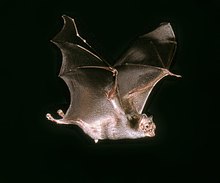| Common vampire bat | |
|---|---|

| |
| Scientific classification | |
| Domain: | Eukaryota |
| Kingdom: | Animalia |
| Phylum: | Chordata |
| Class: | Mammalia |
| Order: | Chiroptera |
| Family: | Phyllostomidae |
| Genus: | Desmodus |
| Species: | D. rotundus
|
| Binomial name | |
| Desmodus rotundus (Geoffroy, 1810)
| |

| |
| Common vampire bat range | |
The common vampire bat (Desmodus rotundus) is a small, leaf-nosed bat native to the Americas. It is one of three extant species of vampire bats, the other two being the hairy-legged and the white-winged vampire bats.
The common vampire bat practices hematophagy, mainly feeding on the blood of livestock. The bat usually approaches its prey at night while they are sleeping. It then uses its razor-sharp teeth to cut open the skin of its hosts and lap up their blood with its long tongue. The species is highly polygynous, and dominant adult males defend groups of females. It is one of the most social of bat species with a number of cooperative behaviors such as social grooming and food sharing. Because it feeds on livestock and is a carrier of rabies, the common vampire bat is considered a pest. Its conservation status is categorized as Least Concern by the International Union for Conservation of Nature (IUCN) because of "its wide distribution, presumed large population tolerance of a degree of habitat modification, and because it is unlikely to be declining at nearly the rate required to qualify for listing in a threatened category."
- ^ Barquez, R.; Perez, S.; Miller, B.; Diaz, M. (2015). "Desmodus rotundus". IUCN Red List of Threatened Species. 2015: e.T6510A21979045. doi:10.2305/IUCN.UK.2015-4.RLTS.T6510A21979045.en. Retrieved 17 March 2022.
